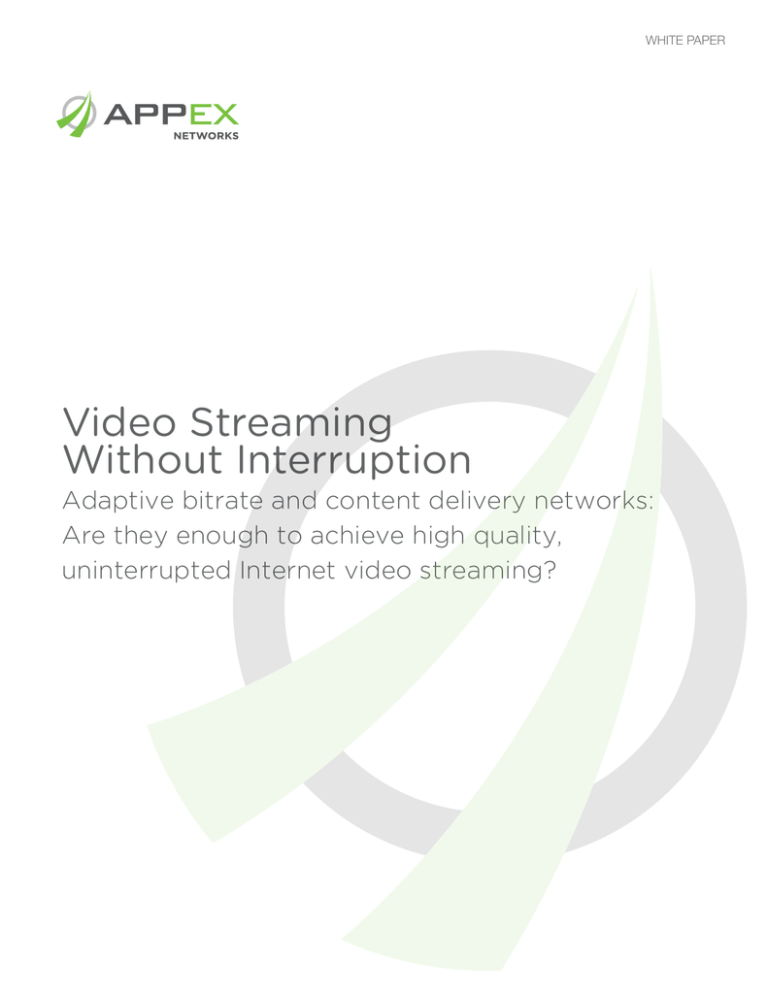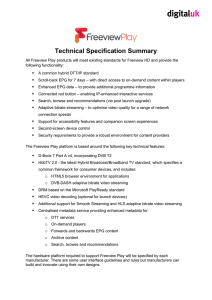
WHITE PAPER
Video Streaming
Without Interruption
Adaptive bitrate and content delivery networks:
Are they enough to achieve high quality,
uninterrupted Internet video streaming?
Abstract
The increasing popularity of video delivery platforms on the Internet is driving the need for
reliable content delivery services. Ninety percent of today’s Internet traffic is video, with
Netflix alone accounting for 21 percent, according to a Cisco Systems report. Cable
companies, pay and broadcast networks, online media companies, and motion picture
production and distribution services are searching for ways to improve performance in order
to overcome the challenges of delivering video content smoothly, at high resolution and
without the frustrating interruptions of re-buffering.
Since video streaming technology was introduced in the 1990s, new Internet protocols and
data delivery technologies have been developed to provide a better viewing experience. Two
of the most prominent developments in this area are adaptive bitrate streaming and Content
Delivery Networks (CDNs). Both have improved video streaming and quality considerably.
However, the stakes have been raised with the rapid growth of video traffic, the advent of
HD streaming content, which requires high throughput rates, and a growing consumer
expectation for cable-quality delivery.
Even with these advances, web-delivered video can be low resolution with jerky delivery.
This is due to the unpredictable nature of data transport and latency on the Internet. The
bursty nature of Internet traffic means frequent network congestion which holds up video
packets and starves receive buffers on a video player, resulting in a pause for more data to
refresh the buffer.
This paper discusses transport acceleration, a new video streaming technology, and how it
can be deployed to deliver the uninterrupted, high quality video viewing experience today’s
Internet users expect.
History of Internet Video Streaming
The first attempts to display media on computers dates back at least four decades ago, but the
rudimentary technology did not advance for many years due to lack of PC CPU power, bus
bandwidth and network throughput.
In the late 1990s, the graphic power of PC and the bandwidth of the Internet finally caught
up, making decent-quality video streaming possible. This paved the way for the advent of
YouTube and showed the world the potential of the Internet for delivering video content.
Techniques for Improving Video Quality
The success of YouTube and other early video streaming players attracted new market
entrants. These new entrants offer either for-pay or ad-supported video models – both of
which require great performance to attract and keep viewers. This in turn has helped to spur
the evolution of the HTTP protocol to support adaptive bitrate streaming to improve video
performance.
Adaptive bitrate streaming technology is embedded into leading computer and tablet video
players and communicates with the video server to control the video flow. It replaces earlier
protocols such as the Real-time Transport Protocol (RTP) and the Real Time Streaming
Protocol (RTSP).
1
Video Streaming Without Interruption
© 2013 AppEx Networks Corporation. All rights reserved.
Adaptive bitrate streaming works by monitoring the user’s bandwidth and CPU performance
in real-time and adjusting the quality of the stream accordingly throughout the viewing
experience. The technology automatically adapts the user’s network and playback conditions
when conditions change, and allows video streaming of much higher quality than was
previously possible.
Adaptive bitrate delivers faster start times and reduces buffering by constantly adjusting the
resolution of the stream, but this compromises steadiness of the stream, resulting in fuzziness
and distortion. This problem is exacerbated by new High-Definition (HD) picture technology,
which offers higher resolution and therefore more data-heavy. In many cases, the resolution
of an HD stream is diminished drastically to maintain the steady flow of the video, but
sometimes, even that’s not enough to keep the users from a buffer refresh.
CDNs
Another emerging technology for Internet video streaming is the Content Delivery Networks
(CDNs). CDNs offer faster start times by caching video content in servers spread out
geographically in Points-of-Presence (PoPs) that are close to end-users. A copy of the video
is stored in each of these servers. When a user requests that video, the request is routed to
the PoP closest to them, shortening the distance the content has to travel and improving
quality by reducing latency. CDNs are complementary to adaptive bit rate streaming
technology and the two can be combined together to provide even higher quality streaming.
But even the combined solution doesn’t always result in perfect video delivery. While CDNs
get the content closer to the customer, they don’t address the last mile problem – the
distance from the PoP to the end-user’s device – and they can’t completely solve the
buffering issue. In addition, CDNs only address content that is stored in their PoPs, so they
are not useful for live streaming that comes directly from the origin server.
Transport Acceleration
The stakes are high in the world of video delivery as user frustration can kill a business
model. As such, the industry is adapting new technologies that promise to end buffer refresh
pauses. Transport acceleration, a new method introduced to the market recently, works with
both adaptive bitrate and CDNs to accelerate video streaming.
Transport acceleration boosts the speed of the video data from the server to the end-user –
whether it’s coming from an origin server or from a CDN PoP – by replacing bursty traffic
patterns with a more even and high-speed data flow. This traffic flow is ideal for video and
other real time traffic because it keeps video player receive buffers full, so that the play
buffer is rarely waiting for content. This reduces annoying buffering pauses and other delays,
thus delivering a smoother viewing experience.
Transport acceleration also delivers the highest quality video picture because the adaptive
bitrate technology does not need to constantly adjust the resolution of the video in order to
decrease buffering.
Transport acceleration technology is integrated into a network near the video server – either
the origin server or the CDN PoP. This eliminates the issues of distance and the last mile
connection quality because the video stream is accelerated all the way from the origin to the
end user.
2
Video Streaming Without Interruption
© 2013 AppEx Networks Corporation. All rights reserved.
AppEx ZetaTCP®
AppEx ZetaTCP® is the leading transport acceleration software solution. It is based on the
company’s Learning Based Technology®, which was developed to boost data transport
speeds.
AppEx transport acceleration combines patented algorithms to:
1) Dynamically adjust data transfer rates to match congestion levels,
2) Eliminate TCP slow-start,
3) Recover lost packets much more quickly than normal TCP, and
4) Dynamically adjust sender and receiver windows to maximize throughput.
ZetaTCP® accelerates dynamic websites, video streams, virtualized desktops and file
downloads by combining intelligent window sizing and smart congestion control to reduce
the effects of network latency and packet loss. It accelerates video streaming and downloads
across the Internet or private networks to improve quality and playback performance. Videos
start up to five times faster and streaming is smoothed out to eliminate playback hiccups
and delays.
AppEx ZetaTCP® excels at higher latencies. It increases throughput, keeps packets flowing
smoothly, recovers from data and packet loss quickly, smooths out video transmission, and
enables faster transfer speeds.
Figure 1. Average initial start time of VoD customers
Figure 2. Re-buffering reduced or eliminated
Figure 1. The dramatic difference in video
throughput being streamed with and without
AppEx acceleration technology implemented.
Content
was
delivered
from
a
cloud
infrastructure from the United States to Asia.
With AppEx acceleration technology, initial start
time decreases dramatically. AppEx smooths
the performance as well.
Figure 2. Average re-buffer rate per session
hour of video on demand being served from the
United States to Asia. With AppEx acceleration
technology, the re-buffering rate drops
significantly.
3
Video Streaming Without Interruption
© 2013 AppEx Networks Corporation. All rights reserved.
AppEx works in conjunction with CDNs and Front End Optimization (FEO) solutions. AppEx
strives to deliver the best viewing experience possible by stabilizing the video streams and
minimizing the effects of packet loss and jitter. It ensures that data streams from the server
to the end user’s video player at a constant rate, with minimal delay. This virtually eliminates
the last mile delivery problem.
Adaptive bitrate technology also benefits from AppEx technology. AppEx acceleration
technology ensures that the maximum bitrate quality and minimum buffer refreshes in the
end user’s video player.
Conclusion
Advancements in fixed and mobile network technology and Internet protocols have unfolded
a whole new world of entertainment for web users. It has also opened up a golden revenuegenerating opportunity for cable companies, pay and broadcast networks and online media
companies to offer media streaming services over the Internet.
When video streaming technology was in its infancy, early adopters were so excited about
the possibility of watching videos on their computers that they were willing to tolerate poor
picture quality, frequent pauses and interruptions. Now that the technology has advanced
and video streaming has become a prevalent form of entertainment for even the most
technology-ignorant users, poor quality and frequent buffering pauses are no longer
tolerated – especially if the user has paid a service provider for the content.
Today’s users demand a smooth and uninterrupted viewing experience. A new network
technology is needed to improve the speed of data delivery and ensure consistent quality of
delivery to end users.
AppEx offers ZetaTCP®, the leading transport acceleration technology. ZetaTCP® works in
conjunction with CDNs and bitrate technology to boost data transport speed, maximize
throughput, and reduce the effects of network latency and packet loss. AppEx ZetaTCP®
acceleration technology supports content providers’ ambitions to deliver the best viewing
experience to their end users.
4
Video Streaming Without Interruption
© 2013 AppEx Networks Corporation. All rights reserved.
AppEx Networks Corporation
1601 McCarthy Blvd.
Milpitas, CA, 95035
+1 408-973-7898
More information can be found at:
www.appexnetworks.com
For a free trial of ZetaTCP:
download.appexnetworks.com




